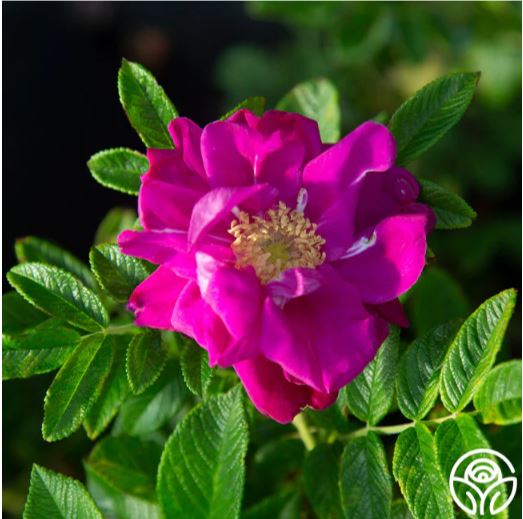Purple Pavement rose

Purple Pavement Rose: A Rugosa Rose with Violet-Mauve Elegance
The Purple Pavement rose, also known as Rosa x ‘Purple Pavement,’ is a captivating addition to any garden. Its violet-mauve semi-double blooms, accented by golden centers, make it a standout choice for gardeners seeking beauty and resilience. This versatile rose excels in various garden settings, from small garden spaces to low hedges, and is prized for its fragrance and hardiness.
Characteristics of Purple Pavement Rose
- Name: Purple Pavement Rose
- Type: Rugosa (Wild) Rose
- Color: Violet-mauve with golden centers
- Petals: Semi-double (9-16 petals)
- Fragrance: Lightly scented
- Height: 2-3 feet (60-90 cm)
- Width: 3-4 feet (90-120 cm)
- Growth Habit: Mounded, spreading
- Foliage: Dark green turning orange-red in fall
- Blooming: Re-blooming from July to September
- Hardiness Zones: 3-10
- Disease Resistance: Excellent
- Special Features: Edible rosehips, superior cold tolerance, moderate suckering
Vibrant Blooms and Fragrance
This rose is celebrated for its semi-double blooms in a striking violet-mauve hue. Each flower boasts a golden center, creating a stunning visual contrast. The blossoms are produced in clusters, adding to the rose’s visual appeal. Notably, this rose emits a light but pleasant fragrance, enhancing the sensory experience in any garden.
Seasonal Interest and Edible Rosehips
One of the standout features of the Purple Pavement rose is its ability to produce showy dark red rosehips in the fall. These rosehips are ornamental and edible, making them a unique addition to the garden. High in vitamin C, they are perfect for making tea, though they have little flavor. The foliage of this rose turns a vibrant orange-red in the fall, providing additional seasonal interest.
Superior Cold Tolerance and Disease Resistance
The rose thrives in a wide range of hardiness zones (3-10) and is particularly noted for its superior cold tolerance. This makes it an excellent choice for gardeners in colder climates. Additionally, the rose exhibits excellent disease resistance, including resistance to fungal black spots, reducing the need for chemical treatments and making it a low-maintenance option.
Ideal Growing Conditions
To achieve the best performance from Purple Pavement Rose, plant it in a location that receives at least six hours of sunlight daily. The rose prefers well-draining soil and benefits from regular watering, especially during dry periods. Pruning after the blooms fade encourages re-blooming and maintains the plant’s shape.
Planting and Spacing
When planting this rose, ensure a spacing of at least three feet apart to accommodate its spreading growth habit. This allows sufficient airflow around the plants, reducing disease risk and promoting healthier growth. The rose has a medium growth rate, typically adding 5-9 inches annually.
Versatile Uses in the Garden
This rose’s mounded, spreading habit makes it suitable for various garden uses. It works well as a low hedge, in mixed borders, or as a standalone specimen in small garden spaces. Its vibrant blooms and attractive foliage make it a focal point in any garden design. Moreover, its moderate suckering habit helps it fill out garden spaces effectively without becoming invasive.
Purple Pavement rose is a delightful addition to any garden with its elegant violet-mauve blooms and golden centers. Its exceptional cold tolerance, disease resistance, and re-blooming habit make it a versatile, low-maintenance choice for gardeners. Whether used as a low hedge, in mixed borders, or as a standalone specimen, this fragrant rugosa rose brings beauty and resilience to the garden. Plant Purple Pavement rose in your garden to enjoy its stunning blooms and unique seasonal interest throughout the year.
